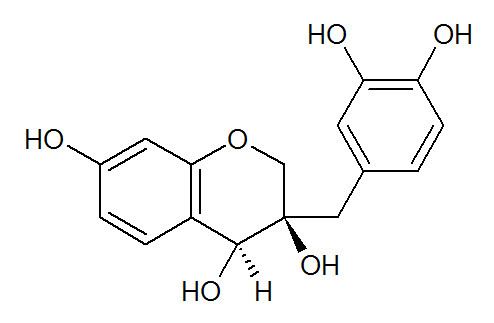 | ||
Homoisoflavonoids (3-benzylidenechroman-4-ones) are a type of phenolic compounds occurring naturally in plants.
Contents
Chemically, they have the general structure of a 16-carbon skeleton, which consists of two phenyl rings (A and B) and heterocyclic ring (C).
Synthesis
Homoisoflavones can be synthetized from 2'-hydroxydihydrochalcones.
Homoisoflavanones can be synthetized from 3,5-methoxy phenols via chroman-4-one in three steps or from phloroglucinol.
Homoisoflavanes can be obtained from the conversion of homoisoflavonoids.
Natural occurrences
The homoisoflavonoids portulacanones A, B, C and D can be found in Portulaca oleracea (common purslane, Caryophyllales, Portulacaceae).
The 3,4-dihydroxyhomoisoflavans sappanol, episappanol, 3'-deoxysappanol, 3'-O-methylsappanol and 3'-O-methylepisappanol can be found in Caesalpinia sappan.
The homoisoflavones scillavones A and B can be isolated from the bulbs of Scilla scilloides (Barnardia japonica).
Homoisoflavanones
Homoisoflavanones (3-Benzyl-4-chromanones) can be found in various plants, notably in Hyacinthaceae (Scilloideae).
Sappanone A can be found in Caesalpinia sappan.
C-Methylated homoisoflavanones (3-(4'-methoxy-benzyl)-5,7-dihydroxy-6-methyl-8-methoxy-chroman-4-one, 3-(4'-methoxy-benzyl)-5,7-dihydroxy-6,8-dimethyl-chroman-4-one, 3-(4'-hydroxy-benzyl)-5,7-dihydroxy-6,8-dimethyl-chroman-4-one, 3-(4'-hydroxy-benzyl)-5,7-dihydroxy-6-methyl-8-methoxy-chroman-4-one and 3-(4'-hydroxy-benzyl)-5,7-dihydroxy-6-methyl-chroman-4-one) can be found in the rhizomes of Polygonum odoratum.
5,7-Dihydroxy-3-(3-hydroxy-4-methoxybenzyl)-chroman-4-one, a homoisoflavanone extracted from Cremastra appendiculata (Orchidaceae), has anti-angiogenic activities and inhibits UVB-induced skin inflammation through reduced cyclooxygenase-2 expression and NF-?B nuclear localization.
In Asparagaceae
3-(4'-Methoxybenzyl)-7,8-methylenedioxy-chroman-4-one, a homoisoflavanone with antimycobacterial activity, can be isolated from Chlorophytum inornatum (Asparagaceae, Agavoideae).
5,7-Dihydroxy-3-(4-methoxybenzyl)-chroman-4-one, 7-hydroxy-3-(4-hydroxybenzyl)-chroman-4-one and 4’-demethyl-3,9-dihydro-punctatin can be isolated from Agave tequilana (Asparagaceae, Agavoideae).
7-O-α-Rhamnopyranosyl-(1→6)-β-glucopiranosyl-5-hydroxy-3-(4-methoxybenzyl)-chroman-4-one, 7-O-α-rhamnopyranosyl-(1→6)-β-glucopiranosyl-5-hydroxy-3-(4′-hydroxybenzyl)-chroman-4-one, 5,7-dihydroxy-3-(4′-methoxybenzyl)-chroman-4-one (3,9-dihidroeucomin), 5,7-dihidroxy-6-methoxy-3-(4′-methoxybenzyl)-chroman-4-one, 5,7-dihidroxy 3-(4′-hydroxybenzyl)-chroman-4-one (4,4′-demethyl-3,9-dihydropuctatin), 5,7-dihidroxy-3-(4′-hydroxybenzyl)-6-methoxy-chroman-4-one (3,9-dihydroeucomnalin) and 7-hydroxy-3-(4′-hydroxybenzyl)-5-methoxy-chroman-4-one can be isolated from the bulbs of Ledebouria floribunda (tribe Hyacintheae). Other compounds can be found in Ledebouria revoluta, a plant widely used as an ethnomedicinal in southern Africa.
The homoisoflavanone glycosides (-)-7-O-methyleucomol 5-O-beta-D-glucopyranoside, (-)-7-O-methyleucomol 5-O-beta-rutinoside and (-)-7-O-methyleucomol 5-O-beta-neohesperidoside can be isolated from the bulbs of Ornithogalum caudatum (tribe Ornithogaloideae).
Scillascillin-type homoisoflavanones (3-hydroxy-type homoisoflavonoids) can be isolated from Drimiopsis maculata (tribe Hyacintheae, Massoniinae).
Eucomin, eucomol, (E)-7-O-methyl-eucomin, (—)-7-O-methyleucomol, (+)-3,9-dihydro-eucomin and 7-O-methyl-3,9-dihydro-eucomin can be isolated from the bulbs of Eucomis bicolor (tribe Hyacintheae, Massoniinae). 4′-o-Methyl-punctatin, autumnalin and 3,9-dihydro-autumnalin can be found in Eucomis autumnalis.
Five homoisoflavanones, 3,5-dihydroxy-7,8-dimethoxy-3-(3',4'-dimethoxybenzyl)-4-chromanone, 3,5-dihydroxy-7-methoxy-3-(3',4'-dimethoxybenzyl)-4-chromanone, 3,5-dihydroxy-7,8-dimethoxy-3-(3'-hydroxy-4'-methoxybenzyl)-4-chromanone, 3,5,6-trihydroxy-7-methoxy-3-(3'-hydroxy-4'-methoxybenzyl)-4-chromanone and 3,5,7-trihydroxy-3-(3'-hydroxy-4'methoxybenzyl)-4-chromanone, can be isolated from the dichloromethane extract of the bulbs of Pseudoprospero firmifolium (tribe Hyacintheae, subtribe Pseudoprospero).
A homoisoflavanone can also be found in Albuca fastigiata (tribe Ornithogaleae).
The same molecule, 5,6-dimethoxy-7-hydroxy-3-(4′-hydroxybenzyl)-4-chromanone, can be found in the bulbs of Resnova humifusa and Eucomis montana (tribe Hyacintheae, subtribe Massoniinae).
Uses
The homoisoflavonoids portulacanones A, B, C and D show in vitro cytotoxic activities towards four human cancer cell lines.
